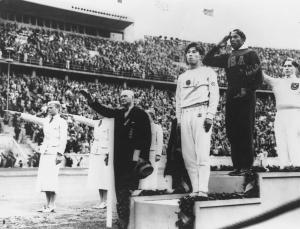Do you know about Yeoseong Gukgeuk? The word translates literally into ‘Traditional Women Opera’. It is a form of Korean traditional play, with narrative songs and dance, which was widely popular before and after the Korean War in 1950s. It is unique that all roles were played by women, which is similar to a Chinese opera where all roles were played by men in the past, and Japanese all-female theater troupe ‘Takarazuka’ which is still popular. It is surprising to know that similar forms of art existed in Korea. How did it look like in its golden age? And why did it disappear?
Ⅰ. The Dawn of a New Era
Yeoseong Gukgeuk is a Korean traditional music performance where both male and female roles are played by women. The first Yeoseong Gukgeuk came out in 1948 as ‘Okjungwha’, a Korean opera produced by the Women’s Korean Traditional Music Association, derived from Chang-geuk, the combination of Pansori(a Korean genre of musical storytelling) and a play of gender mixed actors. The piece was made as an attempt to create a stage for women’s own, as many actresses felt repelled from the authoritarianism of men in the Korean traditional music world. Yeoseong Gukgeuk began to appeal to the mass audiences by the 1950s, also called National Opera, and made a history when women artists created and occupied one of the most successful genres in pop culture. Also, it was the only cultural art performances that was closest to the people’s heart and life after war.
After the Korean War, the number of performance teams, theater pieces, actresses and audiences for Yeoseong Gukgeuk had flourished. The theater was always full and turned many guests away from its doors. As the number of women aspiring to be involved in Yeosung Gukgeuk increased, it is known that several teenage girls ran away from home to become actresses. More importantly, the supply of talented male-performing actors became assured. This was essential in that the success of play relied heavily on the popularity of male-role actresses. At the same time, there was huge inflow of experienced workers in other fields including producing, script writing, stage design, administrative planning and so on.
Although Yeosung Gukgeuk is based on traditional Pansori, it created a new genre in terms of a theatrical style that accepted the historical demands of mass audiences during the process of modernization in Korea. Pansori involves a singer, paired with a drummer, telling an extensive narrative with a combination of pansori (song), talk, and gestures. Furthermore, Yeoseong Gukgeuk uses multiple women singers, a solo drummer is substituted with a band, and dramatizes the narration along with a little dance. Yeosung Gukgeuk applied traditional Pansori culture with the unique characteristics of its theatrical style, along with characteristics of other traditional theatre, while transitioning into a new theatrical style that accepted modern diversity during a time of Westernization.
The main story of Yeoseong Gukgeuk can be divided into a classic novel based drama and historical drama. There are also performances of adapted Western classic literature such as ‘Romeo and Juliet’, ‘Othello’ and ‘The Count of Monte’. Most of the works were in the romance genres which gave pleasure and comfort to the audiences. They could temporarily ignore their harsh realities by watching a drama of a good character rewarded after pain, or a heroic male character rescuing his lover and country after all kinds of troubles. People felt visual fascinations through the bright costumes, unique vocal and movements, and the overall splendid stage settings.
Ⅱ. Believed that the Sun Never Sets
Yeoseong Gukgeuk began its decline both internally and externally from the late 1950s. Because of the introduction of TV and Hollywood movies in Korea, the number of drama pieces decreased and its popularity began to shrink. Then, the articles and columns about Yeosung Gukgeuk started competitively reviling the genre as a mutant tradition.
In the 1960s, many cultural art organizations were provided national aid in their recession. Pansori was designated as a cultural property, and Kim Yeon-su was appointed as the head of Korean opera troupe. He had lost his opportunity for his co-ed opera performance to be successful because of explosive popularity of Yeoseong Gukgeuk in the past. However, Yeoseong Gukgeuk was ruled out of all national supports by the military dictatorship government in the 1970s.
It was certain that Yeosung Gukgeuk’s motives were not aimed at traditional culture, and didn’t have sufficient resources to cultivate a contemporary style. But it is hard to describe confusion within the Yeseong Gukgeuk community just as a chronic friction among women. It is more true to say that there were the structural problems of Yeosung Gukgeuk. In particular, as an ‘all-women organization’, women went through difficulties and struggles that made them leave the organization according to the pressures of marriage, which is the demand of traditional gender roles amongst society. Therefore, it was difficult to imagine career stages with a long-term perspective as a producer, director or any jobs other than the limited role as an actress.
Ⅲ. Longing for Girl Princes
Sadly, Yeoseong Gukgeuk disappeared in the late 1960s but there were some rare movements attempting to recover the prominence of the past. After the 1990s, about two hundred pieces of Yeoseong Gukgeuk were produced and sponsored by the National Cultural Funding Project. However, despite the effort to revive it, many actresses were already in their elderly age and several first generation actors have passed away, making it difficult to put them back on stage.
However, research, books, and re-creations related to Yeosung Gukgeuk are being produced steadily. The comic book series ‘Chun-aeng Jeon’ deals with the life story of Lim Chun-aeng , the most popular performer in the 1950s. Also in April 2012, the documentary film ‘The Girl Princes’ was released, and the Naver Webtoon ‘Jungnyeoni’ covers the story about the actress of Yeoseong Gukgeuk.
In 2016, the artist Jung Eun-young, who designed a exhibition titled ‘Trans-Theatre’ and a performance ‘Irregular Fantasy’ was rewarded with the ‘Artist of the Year’ award from the National Museum of Contemporary Art in 2018. Based on thorough investigation and analysis about Yeoseong Gukgeuk, she gets people to face Yeoseong Gukgeuk as an contemporary issue, and not just a lost history.
Cho Suyeon sooyon5o@gmail.com
<저작권자 © 홍익대영자신문사, 무단 전재 및 재배포 금지>





